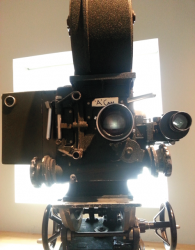“A film is – or should be – more like music than like fiction. It should be a progression of moods and feelings. The theme, what’s behind the emotion, the meaning, all that comes later.” – Stanley Kubrick
Imagine, as you walk through Stanley Kubrick: The Exhibition (October 31 to January 25 at the TIFF Bell Lightbox), that you have an iPod loaded with music from Kubrick’s films. Listening to this music as you stroll would further illuminate the artefacts from the filmmaker’s extensive archives that already comprise an extraordinary glimpse into the working habits and intellect of one of the most thorough directorial minds the world of cinema has ever seen.
Prokofiev’sNevsky: The first piece on that iPod, perhaps surprisingly, would have to be Prokofiev’s soundtrack to Eisenstein’s Alexander Nevsky (1938), which Kubrick bought after seeing the film with Alexander Singer, a friend from high school (and later a director himself). Kubrick was so obsessed with the record that he played it continually, well over 100 times, so much so that his younger sister, fed up, broke it “in an absolute rage,” Singer said. “Stanley never got over [the battle on the ice].”
But it was not only the film’s music that made its mark – it was the whole working relationship between Prokofiev and Eisenstein that fascinated Kubrick. They worked in tandem in the editing room, Eisenstein sometimes varying his cut to correspond with Prokofiev’s music and the composer occasionally reworking his score to dovetail with the director’s wishes.
This is precisely the way Kubrick worked with Alex North on Spartacus, Wendy Carlos on A Clockwork Orange, arranger Leonard Rosenmann on Barry Lyndon and music editor Gordon Stainforth on The Shining.
Fried’sSuite from the Early Films: Your iPod will now be ready to shuffle on to Gerald Fried’s Suite from the Early Films of Stanley Kubrick. Born in the same year as Kubrick (1928), at 17 or 18 Fried was a baseball and football-playing pal. He was also a Juilliard-trained oboist who was entrusted with writing the scores for five early Kubrick films, from Day of the Fight (1951) to Paths of Glory (1957). The brashness of 22-year-olds knew no bounds. The music ranges from big and brassy orchestral in Fight to the woodwind-centric atonal lilt of Fear and Desire; from a typical 1950s B-movie post-romantic Killer’s Kiss to the busier B-movie palette of The Killing, which Fried called “the most primal music I could think of.”
The percussive score to Paths of Glory used snare drums to set up the rank militarism of the film, but it was the impact of the traditional German song, “The Faithful Soldier” sweetly sung by Susanne Christian, that underscored the emotional impact of the movie’s anti-war message. Christian, whose real name was Christiane Harlan, made a lifelong impression on the director. She became his third wife shortly thereafter, and her brother Jan Harlan became a close confidant and executive producer of Kubrick’s films from Barry Lyndon onwards. Fried, meanwhile, went on to score several movies for Roger Corman (including Jack Nicholson’s debut The Cry Baby Killer) before concentrating on TV series work, from Gilligan’s Island, Star Trek and The Man from U.N.C.L.E. to Mission Impossible.
We’ll skip by Spartacus (1960) in our exhibition soundtrack. After Kirk Douglas hired him to direct it, Kubrick never made a film over which he didn’t have complete control. Douglas gave North more than a year to complete the score, so he had ample time to research ancient Roman music and collaborate with Kubrick, who encouraged him to listen to Prokofiev’s Alexander Nevsky. North’s lush, suitably epic soundtrack took up over two hours of the film’s 197 minutes and was nominated for an Oscar.
Lolita Ya Ya: Lolita (1962) was Kubrick’s last film with a traditional score and the director knew what he wanted it built upon – an unforgettable, perfectly apt, bittersweet tune written by his producing partner James Harris’ brother Bob. Knowing this, Kubrick’s first choice, Bernard Herrmann, refused to do the score, so Nelson Riddle was hired. He ended up writing the iconic “Lolita Ya Ya,” a pop confection that was the ideal match for Sue Lyon’s lollipop-licking nymphet. Part of the Kubrick archives but not included in the Lightbox exhibit are outlines for Lolita’s screenplay, drastically different from the final version and (equally revealing of Kubrick's obsessiveness) Kubrick’s handwritten draft of Lolita’s letter to Humbert. Curiously, Kubrick played Sinatra albums for Lyon on the set to get her into the emotional mood he wanted.
Tenderness plus: Two songs, “Try a Little Tenderness” and “We’ll Meet Again,” bookend Dr. Strangelove (1964), which survives robustly on dialogue apart from a recurring instrumental trope of “When Johnny Comes Marching Home.” Listen to them as you gaze at the set of the War Room. It was the next film that would break whatever mould was left both musically and cinematically.
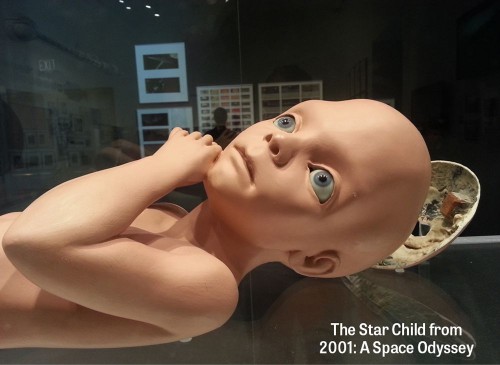 Musical Odyssey: “Movies present the opportunity to convey complex concepts and abstractions without the traditional reliance on words. I think that 2001, like music . . . is able to cut directly through to areas of emotional comprehension. In two hours and forty minutes of film there are only forty minutes of dialogue.” – Stanley Kubrick, 1969.
Musical Odyssey: “Movies present the opportunity to convey complex concepts and abstractions without the traditional reliance on words. I think that 2001, like music . . . is able to cut directly through to areas of emotional comprehension. In two hours and forty minutes of film there are only forty minutes of dialogue.” – Stanley Kubrick, 1969.
And much more than 40 minutes of music – excerpts from György Ligeti’s Atmosphères, Requiem (Kyrie), Aventures and Lux Aeterna account for 32 minutes alone – from the hushed opening bars of Richard Strauss’ Also Sprach Zarathustra and Khachaturian’s Adagio from Gayane (deployed on the Jupiter mission) to the ingenious use of Johann Strauss Jr.’s On the Beautiful Blue Danube which amounted to a reinvention of the cinematic wheel, so breathtaking was the footage of the docking of the space shuttle it accompanied the first time it was heard.
Astronaut Dave Bowman becomes the Starchild as Kubrick brings back Zarathustra. Which is what your iPod should be playing as you gaze at it in the exhibit; the “Starchild” is one of the key attractions along with the dresses of the ghostly sisters from The Shining and the “Born to Kill” helmet from Full Metal Jacket.
Kubrick introduced Ligeti to a massive audience and also used his music in The Shining and Eyes Wide Shut. The composer was said to have been upset that his pieces weren’t used in their entirety in 2001 (his publishers negotiated the rights without fully informing him according to The New Yorker’s Alex Ross) but as Ross writes, he “grew to admire Kubrick’s achievement, and not just because it added greatly to his own fame. It is difficult to think of another mainstream picture in which music in the classical tradition plays such a dominant role ... 2001 is less a dramatic narrative than a concerto for film images and orchestra.”
Some trivia: It was Kubrick’s wife Christiane who first brought Ligeti to her husband’s attention. She had discovered it by chance listening to the BBC and thought it might work in 2001. Kubrick had hired Alex North to write the score and showed him the film with the temp tracks of Zarathustra, Ligeti, Khachaturian and the Scherzo from Mendelssohn’s A Midsummer Night’s Dream to give North an idea of what he was looking for. North scored the picture while admitting he was intimidated by the Mendelssohn in particular. Kubrick wasn’t satisfied (“it could not have been more alien to the music we had listened to”) and given the release schedule reverted to his temp track, with one major change: Strauss’s Blue Danube Waltz replaced the Mendelssohn.
Kubrick revealed his attitude to film music in general in an interview with noted French critic Michel Ciment: “Unless you want a pop score, I don’t see any reason not to avail yourself of the great orchestral music of the past and present. This music may be used in its correct form or synthesized, as was done with the Beethoven for some scenes in A Clockwork Orange. But there doesn’t seem to be much point in hiring a composer who, however good he may be, is not a Mozart or a Beethoven, when you have such a vast choice of existing orchestral music which includes contemporary and avant-garde work. Doing it this way gives you the opportunity to experiment with the music early in the editing phase, and in some instances to cut the scene to the music. This is not something you can easily do in the normal sequence of events.”
Purcell’s Queen Mary: The choice to use Henry Purcell’s Music for the Funeral of Queen Mary in seven separate scenes of A Clockwork Orange (1971) was an inspired one. Even more inspired was to begin the film with the “March” from that work arranged for Moog synthesizer by Wendy Carlos, who according to the director “has done something completely unique in the field of electronic realization of music – that’s the phrase that they use. I think that I’ve heard most of the electronic music and musique concrète LPs there are for sale in Britain, Germany, France and the United States; not because I particularly like this kind of music, but out of my researches for 2001 and A Clockwork Orange.”
British patriotism is evoked sardonically with the use of the first and fourth marches from Elgar’s Pomp and Circumstance. Rossini’s Overture to the Thieving Magpie makes a great partner to Alex’s ultra-violence while the same composer’s Willliam Tell Overture supports a sadder part of his story. Less than two minutes of Rimsky-Korsakov’s Scheherazade are used to accompany Alex’s Biblical prison fantasies. The unconventional, brilliant use of “Singin’ in the Rain” was a sudden inspiration on Kubrick’s part after three days of rehearsal of the difficult rape scene: “Then suddenly the idea popped into my head – I don’t know where it came from or what triggered it off.”
As for the crucial excerpts of Beethoven’s music, the Ninth Symphony is Alex’s theme song and different parts of it appear in several scenes. But for pure irony it’s hard to beat the first four notes of the Fifth, the Fate motif, that Alex hears as he rings the doorbell of F. Alexander’s house.
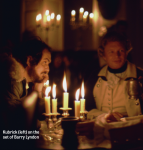 Handel and Schubert: For the music in Barry Lyndon (1975) Kubrick first wanted André Previn, who was too busy, then Nino Rota, who was concerned – rightly – that the director would want little or no original composition, bowed out amicably. Typically, the hiring of Leonard Rosenman as musical arranger, turned out splendidly. Not only did he tweak the classical score to make it fit every crevice of Kubrick’s cinematic landscape, he won an Oscar for his efforts.
Handel and Schubert: For the music in Barry Lyndon (1975) Kubrick first wanted André Previn, who was too busy, then Nino Rota, who was concerned – rightly – that the director would want little or no original composition, bowed out amicably. Typically, the hiring of Leonard Rosenman as musical arranger, turned out splendidly. Not only did he tweak the classical score to make it fit every crevice of Kubrick’s cinematic landscape, he won an Oscar for his efforts.
Kubrick famously wanted nothing in his 18th century drama to be anachronistic, down to the candles that lit the sets after dark. His use of Schubert, the sublime second movement from the Piano Trio Op.100, the German Dance No.1 in C and the first five bars of the Impromptu Op.90 No.1 (to end the first half of the film and begin the second), raised many eyebrows. He had no qualms explaining it to Ciment: “Initially, I thought it was right to use only 18th-century music. But sometimes you can make ground-rules for yourself which prove unnecessary and counter-productive. I think I must have listened to every LP you can buy of 18th-century music. One of the problems which soon became apparent is that there are no tragic love-themes in 18th-century music. So eventually I decided to use Schubert’s Trio in E Flat, Op.100, written in 1828. It’s a magnificent piece of music and it has just the right restrained balance between the tragic and the romantic without getting into the headier stuff of later Romanticism.”
The rest of the score conformed to Kubrick’s original criteria with material ranging widely from Frederick the Great to Mozart, Paisello, Leclair and Bach, with traditional music supplied principally by the Chieftans, all anchored by the Sarabande from Handel’s Suite for Harpsichord No.4 in D minor (which appears ten times). Kubrick had originally thought that Vivaldi’s The Four Seasons would play a prominent role, but he dismissed that idea because he thought the piece had too much baggage and would unduly colour the audience’s perception of the film. He chose Pierre Fournier’s version of the third movement of Vivaldi’s Cello Concerto in E minor instead. It was, of course, from his own collection and illustrated (along with choosing Karajan’s versions of the two Strauss works in 2001) the mindset of someone who would settle only for the best and work obsessively to get there.
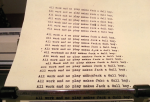 Diverse Penderecki: Of all Kubrick’s films, music was arguably used most effectively in The Shining (1980). Building on the success of A Clockwork Orange, Kubrick continued working with Carlos, who used the Dies Irae melody from the finale of Berlioz’ Symphonie Fantastique as the basis for her music for the first three minutes of the film. In fact she introduced the piece to Kubrick in pre-production; typically he played it more than 100 times before shooting. Carlos added two more themes to the track but the bulk of the score consisted of Ligeti’s Lontano, Bartók’s Music for Strings Percussion and Celesta and selections from nine diverse works by Penderecki, much of which was dissected, reassembled and multi-layered by music editor Gordon Stainforth, whose contribution was essential.
Diverse Penderecki: Of all Kubrick’s films, music was arguably used most effectively in The Shining (1980). Building on the success of A Clockwork Orange, Kubrick continued working with Carlos, who used the Dies Irae melody from the finale of Berlioz’ Symphonie Fantastique as the basis for her music for the first three minutes of the film. In fact she introduced the piece to Kubrick in pre-production; typically he played it more than 100 times before shooting. Carlos added two more themes to the track but the bulk of the score consisted of Ligeti’s Lontano, Bartók’s Music for Strings Percussion and Celesta and selections from nine diverse works by Penderecki, much of which was dissected, reassembled and multi-layered by music editor Gordon Stainforth, whose contribution was essential.
As Christine Lee Gengaro points out in Listening to Stanley Kubrick, her comprehensive guide to the music in his films, music that the characters actually hear in the movie (represented by 1930s popular dance tunes like “Midnight the Stars, and You”) are melodic and friendly while the music that is heard only by the viewer is ominous and a-melodic.
Surfin’ Bird by The Trashmen: Full Metal Jacket (1987) has no classical music in its score. What it does have is popular music evocative of the Vietnam War era, most memorably Sam the Sham and the Pharoahs’ “Wooly Bully” and the ineffable “Surfin’ Bird” by The Trashmen. Kubrick talked about the latter’s effect in a Rolling Stone interview with Tim Cahill: “What I love about the music in that scene is that it suggests post combat euphoria – which you see in the marine’s face when he fires at the men running out of the building: he misses the first four, waits a beat, then hits the next two. And that great look on his face, that look of euphoric pleasure, the pleasure one has read described in so many accounts of combat. So he’s got this look on his face, and suddenly the music starts and the tanks are rolling and the marines are mopping up. The choices weren’t arbitrary.”
No single track serves to exemplify Kubrick’s final film; the underrated Eyes Wide Shut has his most diverse soundtrack. Beginning with Shostakovich’s jaunty Waltz 2 from Suite for Variety Orchestra, it moves through Chris Isaak’s “Baby Did a Bad, Bad Thing” (suggested by Nicole Kidman), original music by Jocelyn Pook, orchestral versions of standards like “I Only Have Eyes for You” and “Strangers in the Night” (which ironically comment on the characters’ relationship), jazz by Oscar Peterson and Brad Mehldau, Nuages Gris by Liszt, “Rex Tremendae” from Mozart’s Requiem and most ominously, the waltz from Ligeti’s Musica Ricercata, with its insistent repetitive semitones, which is used six different times.
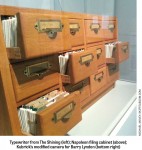 Rosenkavalier Waltzes: By now you will have climbed to the fourth floor where Kubrick’s photographic career with Look magazine is on display. After eyeballing a selection of Kubrick’s personal cameras and lenses, you will have reached the part of the exhibition devoted to Napoleon, A.I. and Aryan Papers, three projects Kubrick worked on but never completed.
Rosenkavalier Waltzes: By now you will have climbed to the fourth floor where Kubrick’s photographic career with Look magazine is on display. After eyeballing a selection of Kubrick’s personal cameras and lenses, you will have reached the part of the exhibition devoted to Napoleon, A.I. and Aryan Papers, three projects Kubrick worked on but never completed.
It’s fascinating to see the bookcase with its glass doors barely able to contain the hundreds of books on Napoleon that Kubrick used for research. Even more germane to the nature of the man’s all-consuming fixation on thoroughness is a filing cabinet with cards detailing day by day and year by year every known fact relating to Napoleon and his whereabouts and activities.
While you take it all in, your iPod is playing a waltz from Richard Strauss’ Der Rosenkavalier, the waltz that Kubrick wanted to use in A.I. Artificial Intelligence, a script he had written that was filmed by Steven Spielberg in 2001, two years after Kubrick’s death. John Williams was able to quote it for 30 seconds on top of his own score for the film, a fitting tribute to a man whose approach to cinema was so musical.
Paul Ennis is managing editor of The WholeNote.



